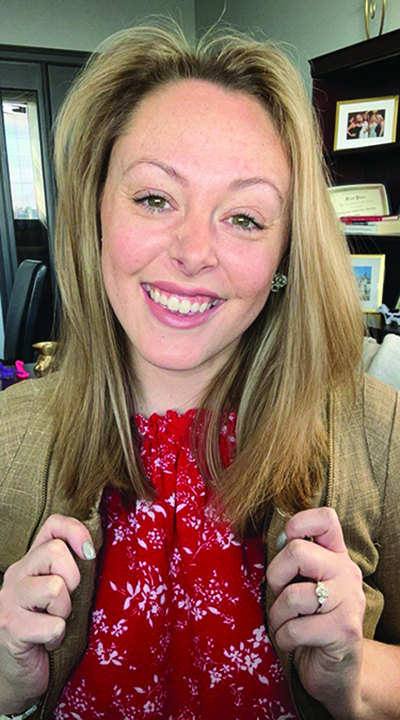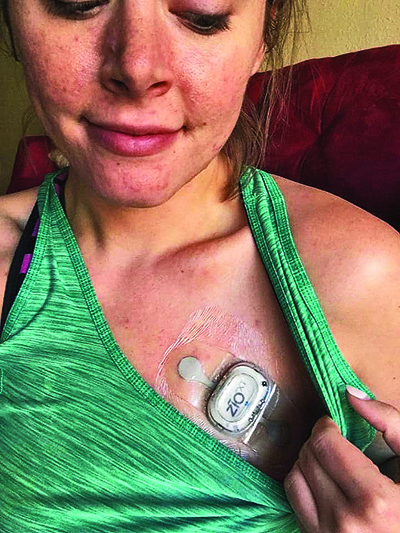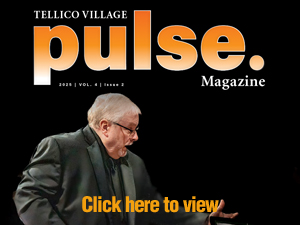Matters of the heart: Smith’s boyfriend advice a life saver
If in doubt about your ‘ticker,’ find a cardiologist
Shannon Smith understands the importance of getting the word out about women’s heart health for a few critical reasons.
Most importantly, she has lived it, being a survivor of a heart condition. In fact, taking the advice of her boyfriend-turned-husband probably saved her life.
Further knowing the importance of getting the word out as Knoxville American Heart Association marketing communications director, Smith was diagnosed with supraventricular tachycardia in 2016 at the age of 23.
But her history started as a teenager.
“It took a while,” Smith said about her diagnosis. “The normal rate for a heart to beat is 60 to 100 beats per minute. Tachycardia is when the heart beats too fast, at a rate of more than 100 bpm, when at rest with seemingly no cause.
“The first time it happened to me I was 17, sitting in a high school history class watching a documentary when my pulse shot up out of nowhere,” she added. “I remember looking around to see if anyone else was doing the same thing, but it was just me.
“The children’s hospital where I grew up in Florida gave me a heart monitor to keep in my backpack to track episodes but never came to a conclusion. Going to college, my friends knew sometimes my heart rate would shoot up and it was just a part of my life.”
Upon entering the workforce after college, “The episodes became more frequent, with my heart rate shooting up to over 200 beats for no visible reason,” Smith said.
“Sometimes it would last for 30 seconds, other times it would wake me up and last for 30 minutes,” she added. “That’s like doing a high-intensity workout but your body is sitting still.
“I went to the cardiologist where I then lived in Texas and they taped a heart monitor to me that I wore 24/7 for a little over a week. This time they were quick to realize what was happening – SVT.”
In detail, “They explained the electrical path my heart was taking was not the straight loop through all four chambers it should be and was essentially short circuiting,” Smith said. “This was likely something I was born with, and it’s common for symptoms to start in teen years as mine did.
“Before I was diagnosed, I was young and didn’t really think it was a big deal,” she added. “It was my then-boyfriend, now-husband who told me having rapid heart beats like this was not normal.
“And they started to become so frequent that it was messing with my day and messing with my head. It was frustrating when an episode would start and I couldn’t figure out how to calm my heart down.
Getting an accurate diagnosis “made me feel like I wasn’t overreacting for noticing these changes in my body, that it wasn’t silly for me to be the youngest person in the cardiologist waiting room by a good 45 years,” Smith said.
“When I got my diagnosis, the cardiologist told me I had three options to treat this,” she added. “One was to take medicine that was known to make people lethargic; and another was to do nothing and have a much higher risk of having a stroke in 20 years.”
The third “was to do a procedure called a cardiac ablation,” Smith said. “This is what I opted for, and it’s when a doctor inserts thin, flexible tubes, called catheters, through the veins or arteries, usually in the groin. Sensors on the tip of the catheter use heat or cold energy to create tiny scars in the heart to block irregular electrical signals and restore a typical heartbeat.
“It worked,” she added. “It was an outpatient surgery, and I was home the same day, just not allowed to lift more than a few pounds for the following week.
“When the doctor told me he recommended an ablation, I learned my mom had actually had the same surgery about 15 years earlier to treat her own heart issue — atrial flutter.”A few years after her surgery, “my maternal grandmother had a stroke, which left her unable to speak and eventually led to her death,” Smith said. “And then I learned her mother also died of a stroke.
“It’s then that I realized because of research funded by groups like the AHA, my mom and I were spared from the same demise her mother and grandmother died from,” she added. “I am recently married to the same boy who encouraged me to visit the cardiologist in Texas almost eight years ago. It’s largely because of him that I no longer deal with SVT.”
The surgery eventually changed Smith’s mindset about sharing her story.
“When I first had to have my ablation, I didn’t tell anyone that didn’t need to know because I didn’t want the pity that came with the words ‘I have to have a heart procedure,’” she recalled.
Later, however, “I have always shared my heart story on National Wear Red Day — the first Friday in February, when people are encouraged to wear red to advocate for women’s heart health,” Smith said.
“And every year, another woman will comment to say she has the same symptoms and had no idea this is something she could get fixed,” she added. “That’s when I realized the importance of talking about these kinds of things.”
With a background in journalism, she was looking to switch career fields when she saw the Knoxville AHA was looking to hire a marketing and communications director.
“I thought, ‘how perfect,’” Smith said. “Not only do I have a strong communications background, but I have directly benefitted from the work of the AHA.
“I knew I’d be able to genuinely support the work we do while still using the skills I’d honed as a reporter,” she added. “And now here we are today.”
“The AHA has actually helped me understand my own heart condition better and I learned how many ways I can be proactive to make sure my heart stays healthy for as long as it can. The biggest way the AHA impacts people that they may not even realize is through research.”
Reflecting back, “Cardiac ablation was not a procedure my grandmother or great-grandmother could have received, but the research and technology that’s evolved because of funding from the AHA gave my mom and I a stronger lease on life with a much, much lower possibility of stroke than the women who came before us,” Smith said.
“Many people who do develop cardiac issues later in life are able to manage them and continue life thanks to the AHA.”




